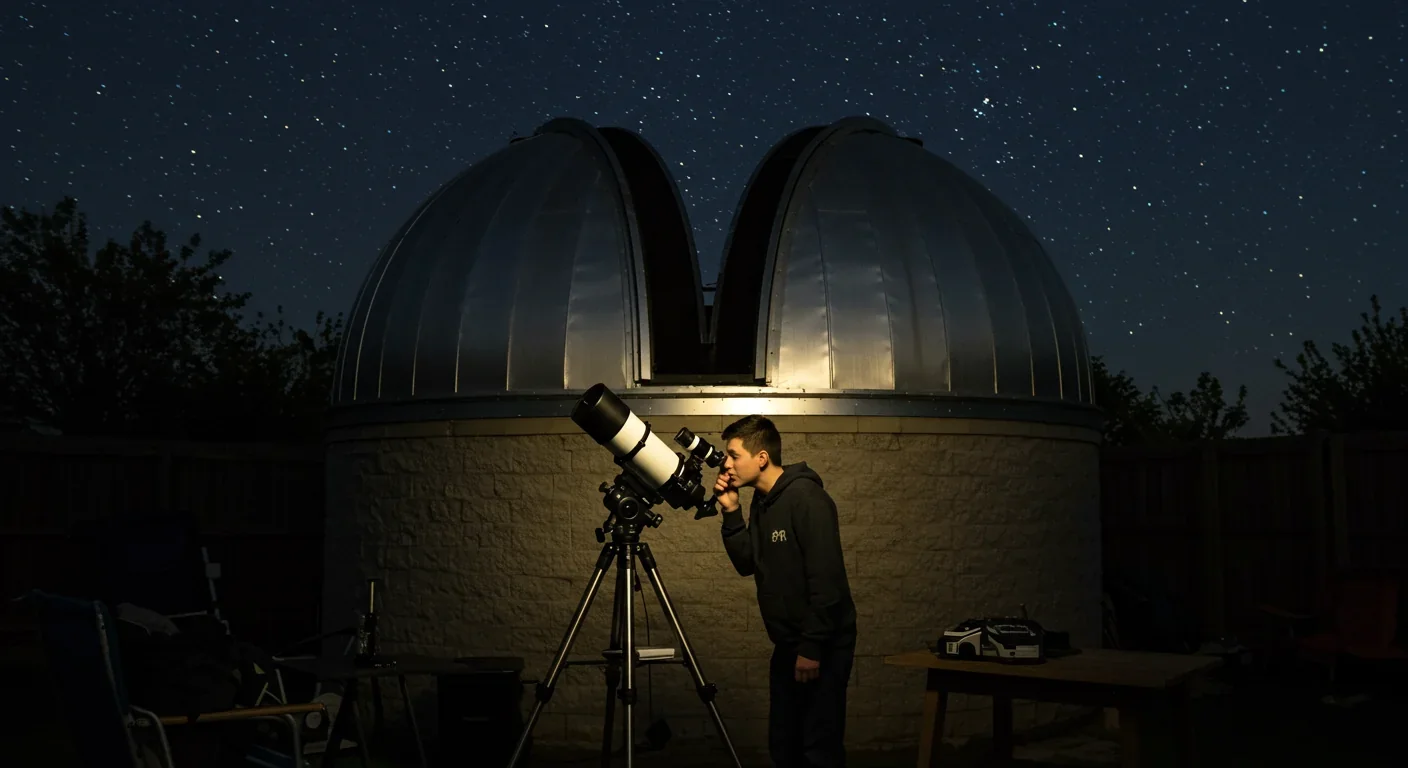Fusion Rockets Could Reach 10% Light Speed: The Breakthrough

TL;DR: 2025 research reveals why we haven't detected aliens: civilizations may evolve past detectable phases in mere decades, radio-bright galaxies hide signals in noise, and we're searching the wrong spectrum with outdated tools.

For seventy years, we've been listening. Radio telescopes have scanned millions of stars, billions of data points, searching for that one signal that would change everything. And for seventy years, we've heard nothing but cosmic static. The Fermi paradox, that haunting question physicist Enrico Fermi posed over lunch in 1950, has only grown louder: where is everybody?
But 2025 is bringing a wave of new scientific proposals that might finally crack this cosmic mystery. And the answer isn't what most people expected.
The most unsettling new theory comes from Michael Garrett's research published in Acta Astronautica. His team built a mathematical model showing that advanced civilizations might be out there in abundance, but we're missing them because of a temporal mismatch so extreme it borders on the absurd.
Think about human technological progress. We went from the first radio transmission to developing AI in roughly 130 years. That's a blink in cosmic time. Now imagine a civilization that accelerates even faster. Garrett's model suggests that the phase where aliens use detectable radio technology, the exact window where we could hear them, might last only a few decades before they advance into something entirely different.
"Our efforts must include but also evolve beyond the search for narrow-band communication signals in the radio and optical domains," Garrett writes. The implication is stark: advanced civilizations may be abundant and long-lived, but effectively invisible to present-day SETI methods.
This isn't science fiction speculation. It's a quantitative framework with testable predictions. And it suggests something profound: the Great Silence might not mean nobody's out there. It might mean we're looking for smoke signals in an age of fiber optics.
While Garrett's team focused on temporal mismatches, Brian Lacki at the Jansky Radio Astronomy Institute took a different approach. His 2025 paper asks: what if entire galaxies are lit up with alien broadcasts, but we can't tell them apart from natural radio emissions?
The concept is elegantly simple. If a galaxy contains thousands or millions of broadcasting civilizations, their collective signal would make the whole galaxy appear "radio-bright." Lacki analyzed data from Breakthrough Listen and calculated the upper limits: fewer than one in 100,000 Milky Way-sized galaxies could host such galaxy-spanning civilizations.
"If you have some subset that has a lot of radio transmissions, they will appear radio-bright," Lacki explained. "The trouble is that you can't tell whether that emission is natural or artificial just from knowing how bright it is in the radio."
This creates a frustrating catch-22. The very abundance that might make aliens detectable as a population also drowns individual signals in noise. It's like trying to hear a single conversation at a packed stadium, except the stadium is the size of a galaxy and you're not even sure if anyone's actually talking.
Lacki's work provides concrete numbers: the abundance of Kardashev Type III civilizations is less than one in 10^17 stars. That's an unimaginably small fraction, but it's also a limit, not a measurement of zero. The civilizations could be there. We just can't distinguish them yet.
Another strand of 2025 research focuses not on detection methods but on the conditions required for life itself. Recent findings suggest Earth's path to hosting intelligent life was even more improbable than we thought.
New research on plate tectonics reveals that technological civilizations might require an extremely specific geological setup. You need active plate tectonics to recycle carbon dioxide and regulate temperature. You need the right balance of greenhouse gases. You need a large moon to stabilize axial tilt. You need a Jupiter-sized planet in the outer system to deflect asteroids.
Stack these requirements together and Earth starts looking less like a typical rocky planet and more like a cosmic lottery winner.
The discovery that Earth was born dry until a cosmic collision delivered water adds another layer. The collision had to be large enough to bring abundant water but gentle enough not to destroy the planet. Too early and the water boils off. Too late and life never gets started. The Goldilocks conditions extend far beyond the habitable zone.
This doesn't mean life is impossible elsewhere. Microbial life might be common. But technological civilizations? The bar might be extraordinarily high.

Here's where the 2025 research gets really interesting: multiple teams are converging on the idea that we've been looking in the wrong places with the wrong tools.
Traditional SETI has focused on narrow-band radio signals, the kind an alien civilization might intentionally beam toward us. It made sense in the 1960s when that's all we could detect. But Garrett's team argues we need to expand to broadband leakage, waste heat signatures, and multi-wavelength anomaly detection.
Think about it: we've been assuming aliens would communicate the way we did in the 1960s. But what if they've moved on to quantum communication, gravitational wave manipulation, or something we can't even conceptualize? Our search strategy has been like looking for candlelight in a city of LEDs.
NASA's plans for the Habitable Worlds Observatory represent a shift in this direction. Instead of listening for deliberate signals, the next generation of instruments will look for biosignatures: oxygen, methane, and other atmospheric markers that could indicate life. It's a broader net, and potentially a smarter one.
The challenge is scale. NASA has now confirmed over 5,000 exoplanets, with estimates suggesting billions more in our galaxy alone. Searching each one thoroughly would take millennia with current technology. We need AI-driven pattern recognition to sift through the data and flag anomalies that human researchers might miss.
Pop culture has latched onto Liu Cixin's "Dark Forest" hypothesis: the idea that civilizations stay silent because the universe is dangerous and revealing yourself invites destruction. It's compelling storytelling, but recent analysis suggests it doesn't hold up to cosmic-scale scrutiny.
The problem with the Dark Forest scenario is the timescale. Even traveling at a fraction of light speed, a civilization could colonize the entire galaxy in a few million years. If predatory civilizations existed, they'd have already swept through. The fact that we exist and haven't been wiped out suggests the Dark Forest is either empty or not particularly dark.
A more nuanced version suggests civilizations might be cautious about broadcasting, but not paranoid. After all, Earth has been leaking radio signals into space for a century. If hostile aliens were listening, they'd already know we're here. The fact that nothing has shown up to destroy us is actually evidence against the most extreme versions of the Dark Forest hypothesis.
What remains possible is something subtler: civilizations might intentionally limit their electromagnetic signatures not out of fear, but out of energy efficiency or communication preferences we don't understand. A civilization using directed laser communication or quantum entanglement wouldn't leave the kind of radio breadcrumbs we're looking for.
Perhaps the most sobering explanation for the Great Silence is that we haven't passed the Great Filter yet. This hypothesis, gaining renewed attention in 2025 discussions, suggests that there's some challenge in the development of civilizations that almost none survive.
It could be nuclear war, climate collapse, artificial intelligence going rogue, nanotechnology disasters, or something we haven't even invented yet. The silence of the cosmos might not be telling us that life is rare. It might be warning us that technological civilizations tend to self-destruct before they spread beyond their home planet.
This interpretation makes the search for extraterrestrial intelligence deeply personal. Every year we don't detect aliens, the probability shifts slightly: either intelligent life is vanishingly rare, or something kills it before it becomes detectable. And since we can observe that life arose on Earth, the second option becomes more statistically likely.
The good news, if you can call it that, is that simply surviving becomes a form of progress. Every decade humanity makes it through without catastrophic collapse is data suggesting the Filter might be passable. Or that it's still ahead of us.

The convergence of these new theories is reshaping SETI strategy in practical ways. Research teams are now pushing for:
Expanded spectral coverage: Moving beyond radio to include optical, infrared, X-ray, and gamma-ray surveys. Lacki's team suggests that technosignatures might be hiding in wavelengths we've largely ignored.
AI-driven anomaly detection: With billions of stars to survey, human researchers can't possibly examine every data point. Machine learning algorithms trained to spot unusual patterns could flag candidates that traditional methods miss. Garrett specifically recommends unsupervised AI discovery across extensive datasets.
Population-level statistics: Instead of looking for individual signals, teams are now calculating what fraction of galaxies could host broadcasting civilizations based on collective properties. It's less exciting than finding a specific alien message, but it narrows the search space.
Biosignature hunting: Rather than waiting for aliens to contact us, NASA's next-generation telescopes will analyze exoplanet atmospheres for signs of life. An oxygen-rich atmosphere around a distant planet isn't proof of intelligence, but it's proof of biology, and that's a start.
The TRAPPIST-1 system, with its seven Earth-sized planets, has become a test case. Three of them orbit in the habitable zone. The James Webb Space Telescope is now capable of detecting atmospheric markers. Within a few years, we might know if any of them harbor life.
Here's something most scientific papers won't tell you: our expectations about alien contact are shaped more by movies than mathematics. When most people think "alien signal," they picture Independence Day or Contact. A clear, unmistakable message that changes everything overnight.
But real searches yield ambiguity. The famous "Wow! signal" detected in 1977 remains unexplained but unrepeated. Was it aliens? A comet? Terrestrial interference? Forty-eight years later, we still don't know. And that's probably what a real detection would look like: unclear, debated, requiring years of follow-up.
The media amplifies this disconnect. Every few months, headlines scream about "alien megastructures" or "mysterious signals," only for follow-up research to reveal prosaic explanations. Tabby's Star, which dimmed mysteriously and sparked speculation about Dyson spheres, turned out to be dust. The "phosphine on Venus" detection that suggested life has been largely debunked.
This pattern creates a boy-who-cried-wolf problem. When a genuine detection finally happens, will anyone believe it?
The 2025 research landscape suggests we're entering a new era of SETI: less about waiting for a message and more about comprehensive surveys of what's actually out there. The Habitable Worlds Observatory, planned for the 2040s, will directly image dozens of Earth-like planets and analyze their atmospheres.
Meanwhile, ground-based efforts are scaling up. The Square Kilometer Array, when complete, will be 50 times more sensitive than current radio telescopes. New statistical methods will let researchers place tighter constraints on the prevalence of broadcasting civilizations, even without detecting a single signal.
And if Garrett's acceleration hypothesis is correct, we might need to look for traces of post-biological intelligence: Dyson spheres that have been abandoned, technosignatures in the cosmic microwave background, or artifacts left behind by civilizations that transcended physical form entirely.
The Great Silence might be teaching us that intelligence in the universe doesn't follow a simple arc from radio to starships. It might explode in directions we can't predict, leaving only the briefest window where detection is possible. And if that's true, the fact that we're looking at all, that we're asking these questions and building these instruments, might be rarer than we ever imagined.
Recent calculations suggest the nearest technologically advanced civilization could be 33,000 light years away. That's not close enough for conversation, but it's close enough to know we might not be alone. And in a universe as vast and ancient as ours, that flicker of possibility might be all we get.
The search continues, now with better tools, smarter strategies, and a humbler understanding of just how hard this problem really is. 2025's theories haven't solved the Fermi paradox. But they've given us new ways to think about the silence, and new reasons to keep listening.

Recent breakthroughs in fusion technology—including 351,000-gauss magnetic fields, AI-driven plasma diagnostics, and net energy gain at the National Ignition Facility—are transforming fusion propulsion from science fiction to engineering frontier. Scientists now have a realistic pathway to accelerate spacecraft to 10% of light speed, enabling a 43-year journey to Alpha Centauri. While challenges remain in miniaturization, neutron management, and sustained operation, the physics barriers have ...

Epigenetic clocks measure DNA methylation patterns to calculate biological age, which predicts disease risk up to 30 years before symptoms appear. Landmark studies show that accelerated epigenetic aging forecasts cardiovascular disease, diabetes, and neurodegeneration with remarkable accuracy. Lifestyle interventions—Mediterranean diet, structured exercise, quality sleep, stress management—can measurably reverse biological aging, reducing epigenetic age by 1-2 years within months. Commercial ...

Data centers consumed 415 terawatt-hours of electricity in 2024 and will nearly double that by 2030, driven by AI's insatiable energy appetite. Despite tech giants' renewable pledges, actual emissions are up to 662% higher than reported due to accounting loopholes. A digital pollution tax—similar to Europe's carbon border tariff—could finally force the industry to invest in efficiency technologies like liquid cooling, waste heat recovery, and time-matched renewable power, transforming volunta...

Humans are hardwired to see invisible agents—gods, ghosts, conspiracies—thanks to the Hyperactive Agency Detection Device (HADD), an evolutionary survival mechanism that favored false alarms over fatal misses. This cognitive bias, rooted in brain regions like the temporoparietal junction and medial prefrontal cortex, generates religious beliefs, animistic worldviews, and conspiracy theories across all cultures. Understanding HADD doesn't eliminate belief, but it helps us recognize when our pa...

The bombardier beetle has perfected a chemical defense system that human engineers are still trying to replicate: a two-chamber micro-combustion engine that mixes hydroquinone and hydrogen peroxide to create explosive 100°C sprays at up to 500 pulses per second, aimed with 270-degree precision. This tiny insect's biochemical marvel is inspiring revolutionary technologies in aerospace propulsion, pharmaceutical delivery, and fire suppression. By 2030, beetle-inspired systems could position sat...

The U.S. faces a catastrophic care worker shortage driven by poverty-level wages, overwhelming burnout, and systemic undervaluation. With 99% of nursing homes hiring and 9.7 million openings projected by 2034, the crisis threatens patient safety, family stability, and economic productivity. Evidence-based solutions—wage reforms, streamlined training, technology integration, and policy enforcement—exist and work, but require sustained political will and cultural recognition that caregiving is ...

Every major AI model was trained on copyrighted text scraped without permission, triggering billion-dollar lawsuits and forcing a reckoning between innovation and creator rights. The future depends on finding balance between transformative AI development and fair compensation for the people whose work fuels it.